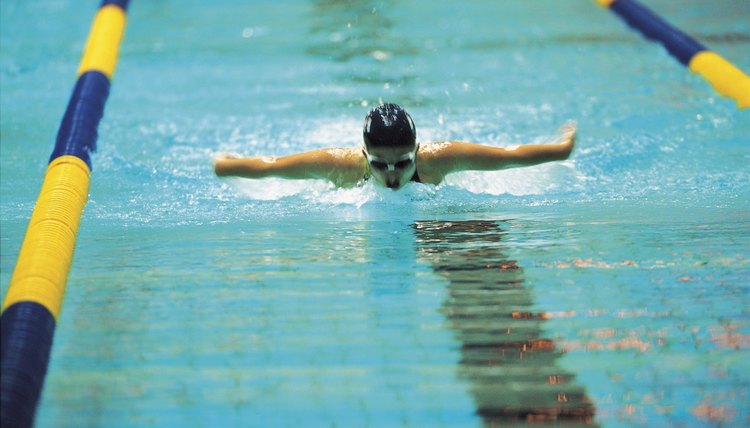How Does an Olympic Swimmer Train?

An aspiring Olympic swimmer may swim 10 to 20 miles per day for years on end to train for an Olympic event that will last anywhere from 20 seconds to 15 minutes. But swimming endless laps is only one part of the Olympic swimmer's training regimen. Diet, weight training and mental conditioning also are essential parts of how an Olympic swimmer trains. Olympic medalist Rebecca Adlington sums it up: "It's all sleeping, training, driving and occasionally finding time to eat."
Miles to Go Before They Sleep
An Olympic swimmer's day usually begins long before the sun rises for a two- to three-hour morning workout before school. Most Olympic swimmers train in pools that are 25 to 50 meters long to accustom their bodies to the standard-length pools for Olympic events. In a single workout, a swimmer may cover nearly five miles at a time. Portions of the workout involve swimming laps of butterfly, backstroke, breaststroke and crawl in timed sets. Other drills include swimming underwater to develop breath control and core endurance; or using swim fins, paddles or kickboards to build specific muscles.
Everybody Out of the Pool
Not all training takes place in the pool. An Olympic swimmer usually has two to three weight-training sessions per week with routines tailored to specific muscle groups used in each stroke. Cross-training may include other sports, such as stand-up paddle boarding to increase core and upper body strength or yoga for flexibility and balance. Natalie Coughlin -- six-time medalist in the Beijing Olympics, uses Pilates. "Thursdays I have out of the water, so I'll do Pilates and walk my dog, but I won't swim." Other no-swim training includes stroke evaluation and mental conditioning.
Training at the Table
A diet high in nutrition and calories is essential to muscle recovery between grueling training sessions, especially for swimmers who are still growing. Foods high in protein aid in muscle tissue recovery. Red meat and other iron-rich foods prevent anemia, common among swimmers during heavy training. Carbohydrates replace muscle glycogen, and sports drinks provide fluid and cell salt replacement. The diet is rich in protein during regular training, but will shift to carbohydrate loading a few days before the Olympic event to provide readily available energy to the muscles.
Tapering Off
Two to four weeks before the Olympic competition, a swimmer tapers off from strenuous workouts. The tapering process results in an increase of red blood cells in the bloodstream, increasing oxygen and mitochondrial activity. Tapering includes a combination of fewer workouts, decreased distances and less intensity. The idea is to allow muscles to fully repair and recover so they are in top form during the Olympic event. Too much tapering may result in a swimmer starting to get "out of shape."
References
Writer Bio
Indulging her passion for vacation vagary through the written word on a full-time basis since 2010, travel funster Jodi Thornton-O'Connell guides readers to the unexpected, quirky, and awe-inspiring.
